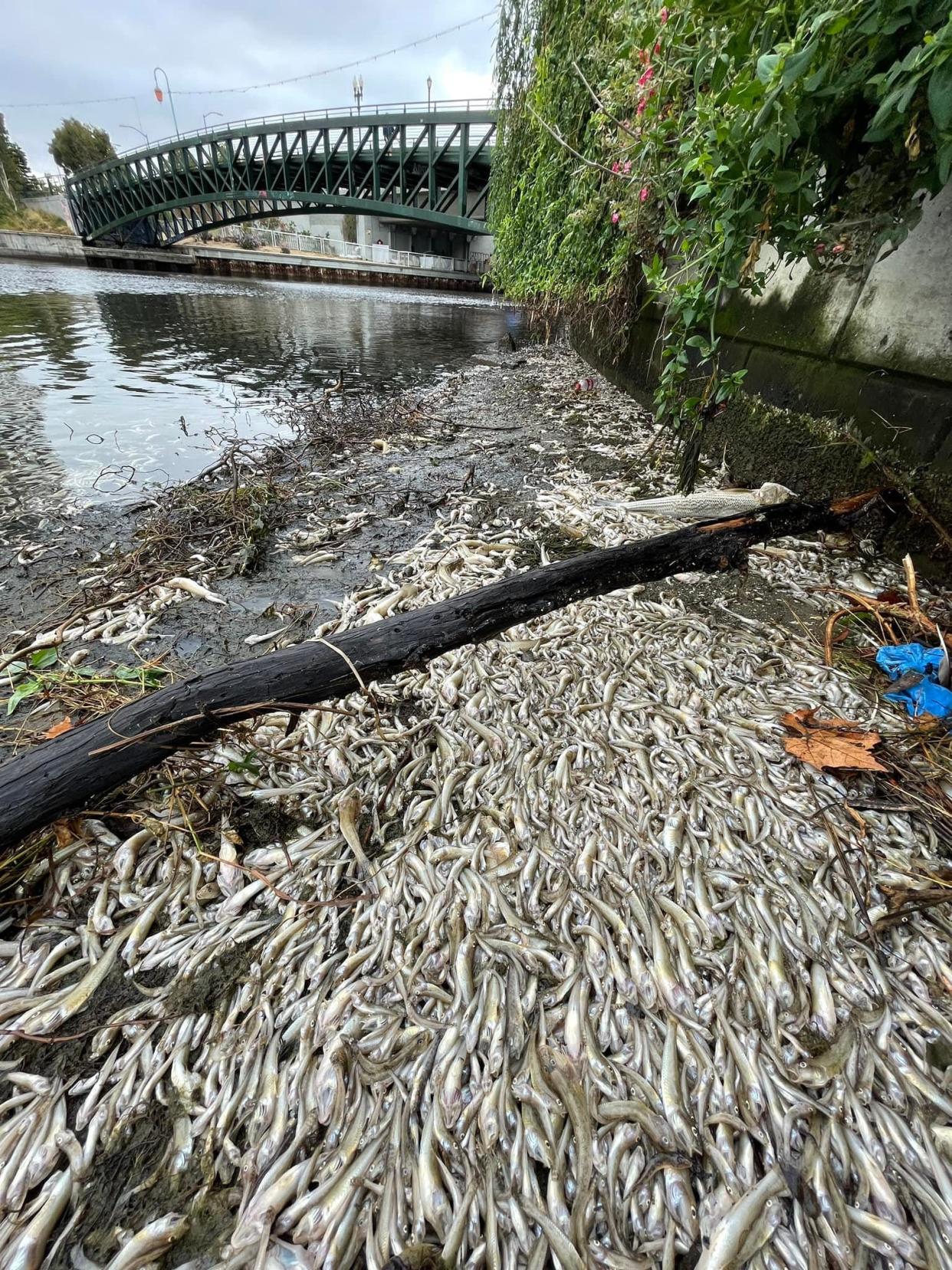Algae bloom triggers widespread fish kill in San Francisco Bay Area: ‘Everything is dying’

An extensive and substantial fish kill, apparently spurred by a large “red tide” algae bloom, is unfolding on San Francisco Bay,
“We began to get reports of dead sturgeon, striped bass, and sharks on Tuesday (Aug 23), from San Mateo County's bayside shoreline off Foster City,” said Dr. Jon Rosenfield, fishery ecologist at the San Francisco Baykeeper, a nonprofit environmental group. “Then a USGS research vessel cruising in the South Bay on Thursday reported large numbers of dead fish, including sturgeon, floating in the water north of the Dunbarton Bridge.”
Subsequent reports of dead fish came in from Alameda, Fort Baker in Sausalito, Point Molate and Keller Beach. By Sunday, the group was getting reports of rafts of small fish from the Alameda estuary and huge numbers of fish from Lake Merritt.
The most likely cause at this point is a red tide, a harmful algal bloom caused by the Heterosigma akashiwo algae species, according to Rosenfield. The species is frequently found in the Bay at background levels.
“This species is associated with massive fish kills elsewhere,” he stated. “It is unknown, at this point, whether the bloom is causing a drop in dissolved oxygen (this is common when large algal blooms begin to die off, or at night, when algal respiration exceeds oxygen production) or producing a toxin that kills fish, or both.”
Rosenfield said this instance of red tide is “unprecedented in its spatial extent and duration.”
“Small, short-lived algal blooms around the Bay's margins are not uncommon. And the southern Delta is regularly plagued by extensive blooms caused by a different species, a cyanobacteria of the genus Microcystis. But nothing of this scope has been reported before in the Bay-proper,” he said.
Striped bass, sturgeon and yellow gobies, are the most common species that are identifiable in the pictures that the Baykeeper have received and during the field investigations they’ve conducted.
Regarding the number of fish that have perished to date, Rosenfield said there is no way at this time to estimate total numbers because people are just seeing a very fraction of the fish that may have died.
Damon Tighe, has a background in biology and chemistry and is a self-described citizen scientist. He has been monitoring the fish kill in Lake Merritt in Oakland. Tighe posted on Twitter and Instagram that he had observed more than 522 dead striped bass and more than 39 dead California bat rays in just the western portion of Lake Merritt between the Cathedral and Lake Chalet on Monday.
On Sunday, Tighe posted a map showing locations around the lake where he estimated more than 10,000 fish representing over 10 species had perished. He included a link to iNaturalist.org, a nature application that allows users to share their observations with other naturalists and scientists, on his posts.
Evidence of the first major die off of the #SFbayHAB2022 is degrading fast in some locations. If you plan on helping get out there ASAP to take observations into @inaturalist . 5+ sturgeon in one cove of #hayward shoreline during high tide. #alagebloom #algalbloom #sfbay pic.twitter.com/6McJYJ4q7U
— Damon Tighe (@damontighe) September 1, 2022
“I have never seen an event this bad. Katharine M. Noonan took a dissolved oxygen reading and Lake Merritt around noon and it is hovering near 0 ppm (parts per million) oxygen. Everything is dying; gobies, flounders, crabs, polychaete works, shrimp, everything,” he said.
“My best bet is this is related to the large Heterosigma algal bloom that started at the beginning of the month in front of Alameda (where effluent pipes for the East Bay discharge). Anoxic conditions can happen for other reasons, but correlation here is making it hard for me to see other options,” he observed.
Rosenfeld said the exact cause of the bloom is a mystery. “The waters of San Francisco Bay are always over-enriched with enough nitrogen and phosphorous to support a large harmful algal bloom,” said Rosenfeld. “Mix that with warm temperatures (which are also not uncommon, during the summer) and sunlight, and uncontrolled blooms are likely.”
“For years, scientists have wondered why extensive blooms are not more common in San Francisco Bay. Estuaries around the world with lower nutrient levels have experienced blooms more frequently than we have -- this year, we were unlucky and the bloom actually occurred,” he stated. See dead fish? Send pictures and report to: https://sfei.org/content/harmful-algal-bloom-fish-mortality
Captain Erik Anfinson, owner of the Bass Tub, who also skippers a passenger ferry from Fisherman’s Wharf to Alcatraz, said he hasn’t seen any dead fish yet while on the water, but noted the bay water is a brown coffee color.
Golden Gate salmon
Salmon fishing has slowed down to a fish per rod, outside of the Golden Gate, but the fish being caught are big ones. Friday’s trip by Captain Zack Medinas of Gatecrasher Fishing Adventures produced 4 salmon to 30 pounds for 4 anglers, while Sunday’s trip yielded 5 kings to 25 pounds for 6 people. Information: (925) 497-7171.
San Joaquin largemouths
Largemouth bass fishing remains steady on the San Joaquin River and adjacent sloughs in the Central Delta. To hook the bigger fish, anglers can expect to catch and release lots of small males, reported Steve Cooper of Stockton, the host of “In Deep on the Delta” Weekly Fishing Report on Thursdays on YouTube. “The bigger fish are being caught by anglers fishing plastic frogs and punching in the weed mats,” he advised.
Contact Stockton Record Correspondent Dan Bacher at danielbacher53@gmail.com.
This article originally appeared on The Record: Algae bloom triggers fish kill in San Francisco Bay Area

